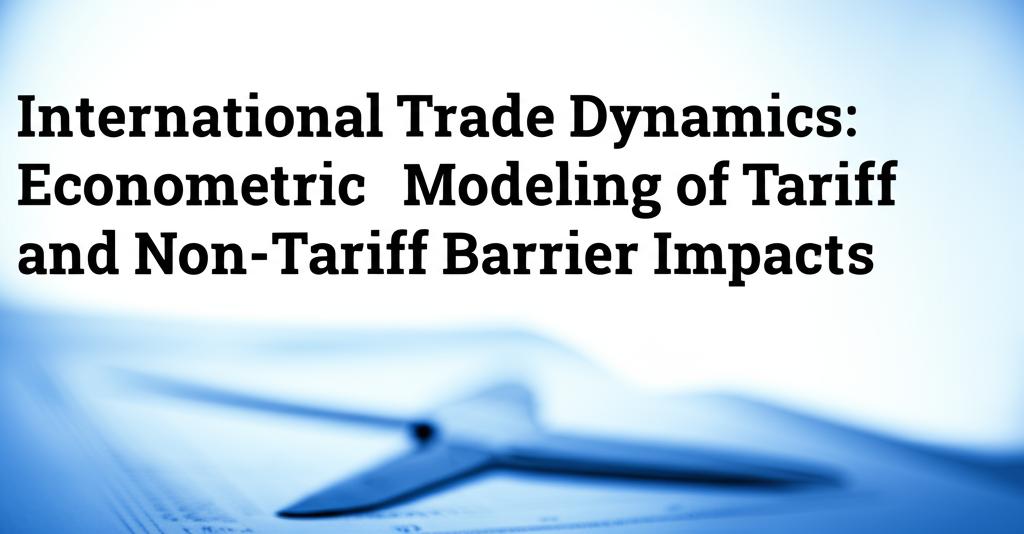Understanding the intricate mechanisms of global commerce is paramount in today's interconnected world. The flow of goods and services across borders is significantly influenced by various policy instruments, broadly categorized as tariffs and non-tariff barriers (NTBs). Econometric modeling provides a powerful toolkit to dissect and quantify the impacts of these measures on international trade dynamics, offering crucial insights for policymakers, businesses, and economists.
While tariffs, which are direct taxes on imported goods, have historically been a primary tool of trade policy, their prevalence has generally declined due to successive rounds of trade liberalization under the World Trade Organization (WTO) and various free trade agreements. However, recent geopolitical shifts and trade tensions have seen a selective resurgence in tariff use, reminding us of their potential to significantly alter trade patterns, raise consumer prices, and impact domestic industries. Econometric studies consistently show that tariff imposition tends to reduce import volumes from targeted countries, potentially divert trade to other nations, and can negatively affect overall economic welfare if not strategically implemented or if they invite retaliation.
More complex and increasingly prominent are non-tariff barriers. NTBs encompass a wide array of policy measures other than explicit tariffs that can affect international trade. These include sanitary and phytosanitary (SPS) standards, technical barriers to trade (TBT), import quotas, subsidies, customs procedures, and rules of origin, among others. Unlike tariffs, the impact of NTBs is not always straightforwardly restrictive. While some NTBs clearly aim to protect domestic industries by raising costs for foreign producers or limiting market access, others, such as certain quality or safety standards (SPS/TBT), can potentially enhance trade by increasing consumer confidence or ensuring compatibility, provided they are not overly burdensome or discriminatory.
Econometricians employ various models to estimate the effects of these trade barriers. The workhorse gravity model of international trade remains a cornerstone, consistently demonstrating that factors like economic size and geographic proximity are key drivers of bilateral trade flows. Tariffs are typically incorporated into gravity models as a trade cost factor, with numerous studies confirming their negative impact on trade volumes. Modeling NTBs within this framework is more challenging due to their diverse nature and difficulties in quantification. Researchers often convert NTBs into ad valorem equivalents (AVEs) – the tariff rate that would produce the same trade reduction effect. This conversion, however, is not always straightforward and can vary significantly depending on the type of NTB and the methodology used.
Recent advancements in econometric techniques and data availability have allowed for more nuanced analyses. For instance, firm-level data is increasingly used to understand how trade policies affect individual businesses’ decisions to export or import, their product scope, and their survival in international markets. Studies using such granular data reveal that NTBs, particularly complex technical regulations or cumbersome customs procedures, can disproportionately affect small and medium-sized enterprises (SMEs) due to higher relative compliance costs.
Computable General Equilibrium (CGE) models offer another important avenue for assessing the economy-wide impacts of tariffs and NTBs. These models simulate how changes in trade policy ripple through various sectors of an economy, affecting not just trade flows but also domestic production, employment, prices, and overall welfare. CGE analyses are particularly useful for evaluating the broader consequences of significant policy shifts, such as the implementation of new trade agreements or the imposition of widespread tariffs. Modern CGE models often incorporate detailed representations of NTBs and their associated costs.
A key challenge in modeling NTB impacts lies in their heterogeneity and the difficulty in obtaining comprehensive, comparable, and quantifiable data across countries and industries. Many NTBs are qualitative in nature, making their conversion into a numerical format suitable for econometric analysis complex. Efforts by international organizations like the WTO, UNCTAD, and the World Bank to collect and classify NTB data are improving this landscape, but gaps remain. Furthermore, the impact of an NTB can depend on institutional quality and regulatory practices in both the exporting and importing countries.
Current research emphasizes the importance of distinguishing between different types of NTBs. For example, regulations aimed at consumer safety or environmental protection might reduce trade in the short term due to compliance costs but could also foster innovation or lead to higher-quality products, potentially benefiting trade in the long run if standards are harmonized or mutually recognized. In contrast, NTBs perceived as overtly protectionist, like arbitrary licensing requirements or subsidies favoring domestic firms, are generally found to impede trade significantly.
In summary, the econometric modeling of tariff and non-tariff barrier impacts is a dynamic and evolving field. While tariffs generally have well-understood trade-reducing effects, the diverse nature of NTBs necessitates sophisticated analytical approaches to capture their varied and often complex consequences. As global trade continues to be shaped by a mix of liberalization efforts and new protectionist tendencies, robust econometric analysis remains indispensable for designing effective trade policies that foster sustainable economic growth and development. Understanding the nuances of how these barriers affect trade flows, costs, and broader economic outcomes is crucial for businesses navigating international markets and for policymakers aiming to create a predictable and fair global trading system.

